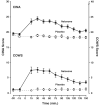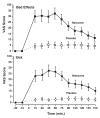Concurrent validation of the Clinical Opiate Withdrawal Scale (COWS) and single-item indices against the Clinical Institute Narcotic Assessment (CINA) opioid withdrawal instrument
- PMID: 19647958
- PMCID: PMC2774236
- DOI: 10.1016/j.drugalcdep.2009.07.001
Concurrent validation of the Clinical Opiate Withdrawal Scale (COWS) and single-item indices against the Clinical Institute Narcotic Assessment (CINA) opioid withdrawal instrument
Abstract
Introduction: The Clinical Opiate Withdrawal Scale (COWS) is an 11-item clinician-administered scale assessing opioid withdrawal. Though commonly used in clinical practice, it has not been systematically validated. The present study validated the COWS in comparison to the validated Clinical Institute Narcotic Assessment (CINA) scale.
Method: Opioid-dependent volunteers were enrolled in a residential trial and stabilized on morphine 30 mg given subcutaneously four times daily. Subjects then underwent double-blind, randomized challenges of intramuscularly administered placebo and naloxone (0.4 mg) on separate days, during which the COWS, CINA, and visual analog scale (VAS) assessments were concurrently obtained. Subjects completing both challenges were included (N=46). Correlations between mean peak COWS and CINA scores as well as self-report VAS questions were calculated.
Results: Mean peak COWS and CINA scores of 7.6 and 24.4, respectively, occurred on average 30 min post-injection of naloxone. Mean COWS and CINA scores 30 min after placebo injection were 1.3 and 18.9, respectively. The Pearson's correlation coefficient for peak COWS and CINA scores during the naloxone challenge session was 0.85 (p<0.001). Peak COWS scores also correlated well with peak VAS self-report scores of bad drug effect (r=0.57, p<0.001) and feeling sick (r=0.57, p<0.001), providing additional evidence of concurrent validity. Placebo was not associated with any significant elevation of COWS, CINA, or VAS scores, indicating discriminant validity. Cronbach's alpha for the COWS was 0.78, indicating good internal consistency (reliability).
Discussion: COWS, CINA, and certain VAS items are all valid measurement tools for acute opiate withdrawal.
Figures


References
-
- American Psychiatric Association, editor. Diagnostic and Statistical Manual of Mental Disorders. Fourth Edition. American Psychiatric Association; Washington, D.C.: 2000. Text Revision.
-
- Blachly PH. Naloxone for diagnosis in methadone programs. JAMA. 1973;224:334–335. - PubMed
-
- Bradley BP, Gossop M, Phillips GT, Legarda JJ. The development of an opiate withdrawal scale (OWS) Br J Addict. 1987;82:1139–1142. - PubMed
-
- Center for Substance Abuse Treatment . Clinical Guidelines for the use of Buprenorphine in the Treatment of Opioid Addiction. Substance Abuse and Mental Health Services Administration; Rockville, MD: 2004. - PubMed
-
- Daftery AV. Letter: Naloxone challenge in propoxyphene dependence. N Engl J Med. 1974;291:979–980. - PubMed
Publication types
MeSH terms
Substances
Grants and funding
LinkOut - more resources
Full Text Sources
Other Literature Sources
Medical
Research Materials

